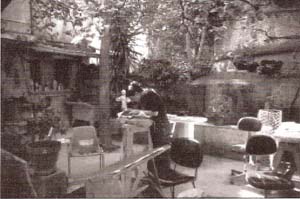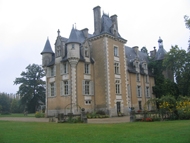Home » Journal Articles » Travel » Art in Other Places: Cities – Nov/Dec 1999
I love visiting cities, especially old, vibrant ones with lots of art. On recent trips, I have been surprised and pleased at how many people got in my way at the museums. It’s not that I’m a crowd lover – it would be great to have whole rooms to myself. And yet it was marvelous to see so many other people choosing to spend their time visiting art. I really enjoy the big museums, packed full of art, usually from other parts of the world. And I particularly like discovering local art where I don’t expect it.
New York has the Metropolitan Museum of Art and the Museum of Modem Art, as well as many other museums and galleries. There is much to see in those museums. I saw plenty that drew me in, and had other very worthy experiences as well. A long New York subway ride took me from Greenwich Village to a working class neighborhood in Queens. After a 15-minute walk I entered the cool, calm oasis that is the Noguchi Garden Museum. If you like Noguchi’s work, this is the place to go. Multiple spaces, indoors and out, create a lovely and introspective setting for his small and large scale sculptures. Some of the big basalts were just begging me to lean up against them and feel their textures. I wish I could have – their presence felt primally reassuring.
In older cities, it pays to keep your eyes open-you never know what you might notice, especially if you just look up. Many New York buildings housing chain stores at street level have wonderful carvings and architectural features on higher floors. I was delighted by the variety and inventiveness of the upper surfaces, even with their coating of decades of city grime. And if you get up high enough, take a look at the old water towers atop the buildings. Not that they are lovely, nor even art, but it was striking to see these formations covering the city. The Guggenheim Museum is very modern with a spiral layout llild an open central core. As I was taking in a motorcycle collection, I could look from the chrome and metallic machines to a large carved lion-esque gargoyle on a neighboring building visible through the ceiling windows-what a vivid contrast! Speaking of lions-those at the entrance to the New York Public Library in midtown are the most regal, proud stone beasts I’ve ever seen-plus it’s OK to touch their weathered flanks. And I like that.
Southern Europe is home to more religious art than r ever dreamed existed. Not being Christian nor especially interested in religious a1t, I wasn’t excited by the prospect of spending my days viewing it. However, it was “art,” and local art at that. Since I was there, I chose to be interested in at least some of it. On my way to Barcelona, Spain, I visited the medium-sized town of Girona. By this point in my travels, I’d seen enough crucifixes to last a lifetime, and would have been happy to see no more. Then I was struck dumb by one in the Girona cathedral. In a dark, quiet niche was a very modern work. Positioned horizontally on the floor was a cross with a terribly gaunt, abstracted Jesus. He was utterly alone. I could feel His suffering. My memory of it still brings tears to my eyes. In the town’s contemporary art museum, I noticed an area blocked off from museum visitors. Naturally, I had to take a look. Several rooms were totally filled with hundreds of large crucifixes, lying on the floor on edge, packed in as tightly as possible. It was disturbing to see all these varied works, all these images of a dying Jesus, crammed together like sardines.
Barcelona is a great and lively city and home to the art of Pablo Picasso, Joan Miro, and Antonio Gaudi. Gaudi is the most imaginative architect I’ve ever experienced. Throughout the city are his finished llild unfinished works – a park, mllily buildings and homes, and the Temple de la Sagrada Familia (The Holy Family Church). Oh my! You have to look hard to see parallel lines anywhere.
The modern gothic buildings are quite literally dripping with fantasy. In Miro’s museum, I spent several hours exploring his joyous world of birds and stars and women and strange fantasies. While I wasn’t particularly moved by his work, I grew quite fond of it and of him during the process. One sculpture, which was someone else’s work, was a fountain that used mercury to trace a complex, curvy path. It was mesmerizing to watch, because mercury, with its higher viscosity, surface tension and density, moves so differently from water. I wanted to plunge my arms right in and feel the pressure of the quicksilver flowing over me. Last, but not least, was the Picasso Museum. My first memory of a great work of art is Picasso’s “The Old Guitarist,” which I saw as a child at the Art Institute of Chicago. I loved it then and still do. Much of his later work failed to move me, nor did I “get it.” The Picasso Museum is laid out chronologically, beginning with his doodles from a very young age. That boy could really draw. Seeing how he progressed, how he explored his craft, what paths he took was so enlightening. It gave me an appreciation for his genius and his creations that I would not have had otherwise.
I must mention Florence, Italy. I fell in love with the city-with its food, its architecture, its energy, and of course, its art. You must go there and experience it all. Florence is where I first really noticed stone sculpture. First were all the giant marble sculptures ringing the central piazza. Then were all the various carvings on every building in sight. Next were the sculptures in the Bargello Museum. But most especially were the unfinished “captives” of Michelangelo in the Galleria dell’ Accademia where David lives. Words aren’t sufficient to describe the emotional impact of my seeing David in all his glory. You just have to go see him yourself. And be prepared to be torn between being drawn toward the magnificent David glowing at the end of the hall and staying with all the intensely powerful captives still contained within their marble blocks. That experience made me see stone sculpture with new eyes and whisper to myself, “Oh I wish I could do that.” Several years later I started carving – and am still wishing I could do it like that!








We need some kind of descriptive text here.